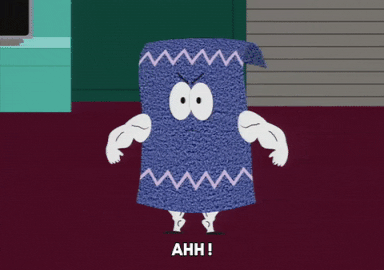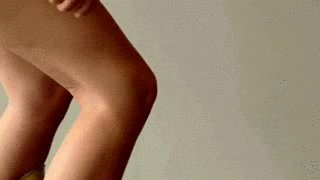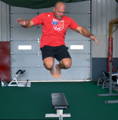How do you strengthen your feet?
Poor reaction time, shin splints, knee problems, rolling one’s ankle all the time are typical attributes of people with weak ankles, or more typically, weak feet. And that is what we want to focus on here: improving the strength of our feet.

Doubters may be saying to themselves, “Does foot strength have any carryover to sports performance?” Well, yes! Studies have shown that sprinters who have more coordination with their big toe run faster. Building on that aspect, we can think about making our toes stronger and more coordinated to help improve the range of motion in our ankles. If we can create a greater range of motion in our ankles, we can create greater stability in our knees as well allowing us to get a steeper shin angle to be able to run faster. Foot strength will carry over tremendously to higher levels of speed, more stable ankle joints, which in conjunction will create more stable knee joints.
Before we jump into the exercises, one thing we have seen at Garage Strength that is consistent with people who have pathetically weak and coordinated toes and feet is that they tend to wear big, bulky shoes. We have to recognize that too large of a sole can lead to the rolling of ankles. We also have to acknowledge that a bigger sole helps with running long distances and improves performance. We believe it is more effective to use a more primitive shoe.
But when we are focusing on improving our foot strength, going barefoot has its benefits. We like to start with two really simple exercises. So let’s go into a very simple routine that can be performed two to three days a week to drastically improve foot strength.
1. Tibialis Raise
The first exercise involves standing on a raised platform. We want the feet in a gapped position, meaning we want a gap between the heel and the forefront of the foot. The heel is on the raised platform with the forefront of the foot hanging off the platform. It is a tibialis raise.

Think about getting nice and low and then elevating the toes back up, dorsiflexing. It is okay to hold onto something while trying to improve balance. This will create a nice pump in the calves as well. Do this movement for two to three sets for fifteen to twenty reps. We want to superset the tibialis raise with our next exercise.
2. Towel Curls
This next movement can be performed sitting down or standing up. It is really easy. Simply do a towel curl. To do the movement, a towel is needed. The movement is performed by putting a towel under the foot and simply flexing the toes to pull the towel into the foot. We want to do this movement for two to three seconds for sets that last for around ten seconds.

3. PVC Pipe Walk
This third exercise, the PVC pipe walk, improves the actions of the toes. It gets the toes moving and digs into the foot to make it more limber. It also makes the foot more elastic which will help with improving reaction time.
We want to walk forward on the pipe, focusing on curling the toes. We also want to walk backward, which will cause more dorsiflexion, improving stability as well. We want to walk back and forth on the pipe. The PVC pipe walk is a great foot strengthening movement.
Get creative while being performing this exercise. Try to push one another, play the game of Rolley-Pulley, throw tennis balls at one another, or any other creative application that can be thought up!
4. Elevated Heel Slant Board Split Squat
This is a very hard, challenging movement. It will be felt in the Achilles tendon. A big key is having the toes grabbing the slant board to create an artificial platform for the heel to stay level.
First, we want to be in a split squat position. Then in the slant board, we want the front foot to grab the slant board and hold the foot level. Holding level, we want to then perform unilateral squats. We can go so far as to load this movement by holding dumbbells in a farmer’s carry position. An added bonus of performing this movement is it will open up the hips.

We can even hold the position isometrically to build strength in the feet. The isometric position is really challenging and is even more badass if access to two slant boards is applicable. We want to do the elevated heel slant board split squat for two to three sets of five to ten reps on each side.
5. Overhead Sprinter Toe Walks
The classic track and field sprinter walk is great. Taking a medball, we extend the arms overhead. On the front of the foot, we walk on what everyone knows as the tippy toes. While performing the toe walks, we want to focus on pulling forward when walking forward and on pushing backward from the bridge of the foot when walking backward.
Just like the PVC pipe walks, we have to think about one action pulling when going forward and pushing when going backward. The toes need to learn how to move in different directions. We are also holding a lot of plantar flexion, which is important for cutting, sprinting, and all the things that go into being fast. In addition, we need to work through all the dorsiflexion, like the tibialis raises, to make sure we have a nice long Achilles tendon to help stabilize the ankles which in turn helps strengthen the feet.
Do this movement for two to three sets of ten to twenty meters.
6. Heel Walks
Heel walks are done by walking in dorsiflexion. It is done, like the toe walks, for two to three sets for ten to twenty meters. The improved dorsiflexion helps with foot strength, lengthening that Achilles tendon, and contributing to the warmth needed for the next, explosive, simple plyometric movement.

7. Bunny Hops Barefoot
This is a real easy plyometric movement. When doing this movement, try not to let the heel touch. It involves a rapid bounce of jumping up and down with minimal bend in the knees. Perform the bunny hops barefoot for two to three sets over distances ranging from five to ten meters.
8. Lateral Side Jumps
This exercise is great for sports with a lot of lateral cutting. The movement involves an object to jump over, like a bench, and we just jump laterally side to side.

We are now training globally around the ankle joint. There are two joints down there. Strengthening the feet and toes helps stabilize those two joints. This helps prevent rolling ankles to protect the joints. It also allows for better tracking of the knee more effectively to accelerate at a higher pace.
9. Barefoot Push Press
Doing technical coordination lifts in barefoot or socks are not to be done until the other eight exercises have been performed for four to five weeks. Using technical coordination movements in this way are primarily geared towards advanced foot strengthening exercises.
Doing movements like the push press or power jerk in barefoot or socks for four or five sets of five reps teaches athletes how to strengthen their feet and proprioception with movements that transfer incredibly well to an athlete’s specific sport. In this case, a barefoot push press or power jerk is a great movement for a football player.
The key is super setting the technical movement, like the push press, with something like a PVC pipe walk.
Recap
Utilize all of these exercises, but be creative. This routine is similar to mobility in that it can be done two to three days a week. It doesn’t need to be crazy. It doesn’t need to be a killer. It is just focusing on improving strength in the ankle, foot, and toes.
DANE MILLER
Dane Miller is the owner and founder of Garage Strength Sports Performance. He works with a select handful of clients on building comprehensive programs for fitness and nutrition. Several times a year he leads a workshop for coaches, trainers, and fitness enthusiasts.



